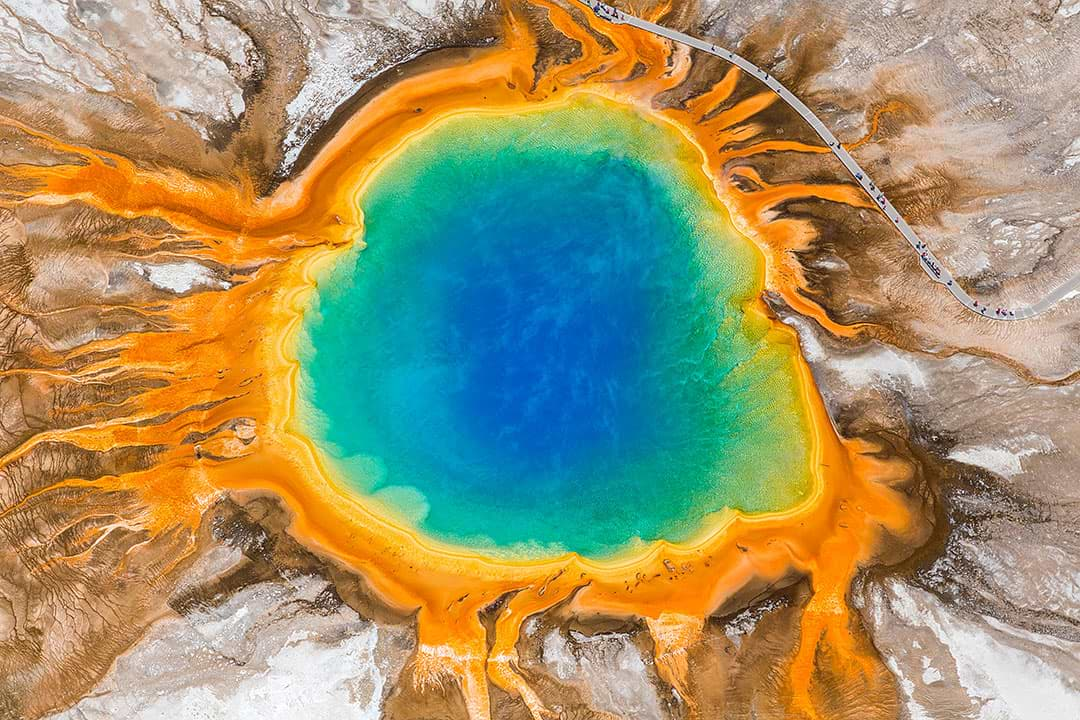Visiting Yellowstone National Park? This is everything you need to know.
Yellowstone National Park is the world’s first national park and is known for its beautiful hot springs, mudpots, geysers, and incredible wildlife. We’ve visited twice, and out of all the national parks we’ve explored so far, it’s been our least favorite because of the type of visitors it attracts. It’s a popular park and even their newspaper will tell you to pack your patience. Here’s our in-depth guide to help you see all the top attractions and then find ways to escape the crowds.
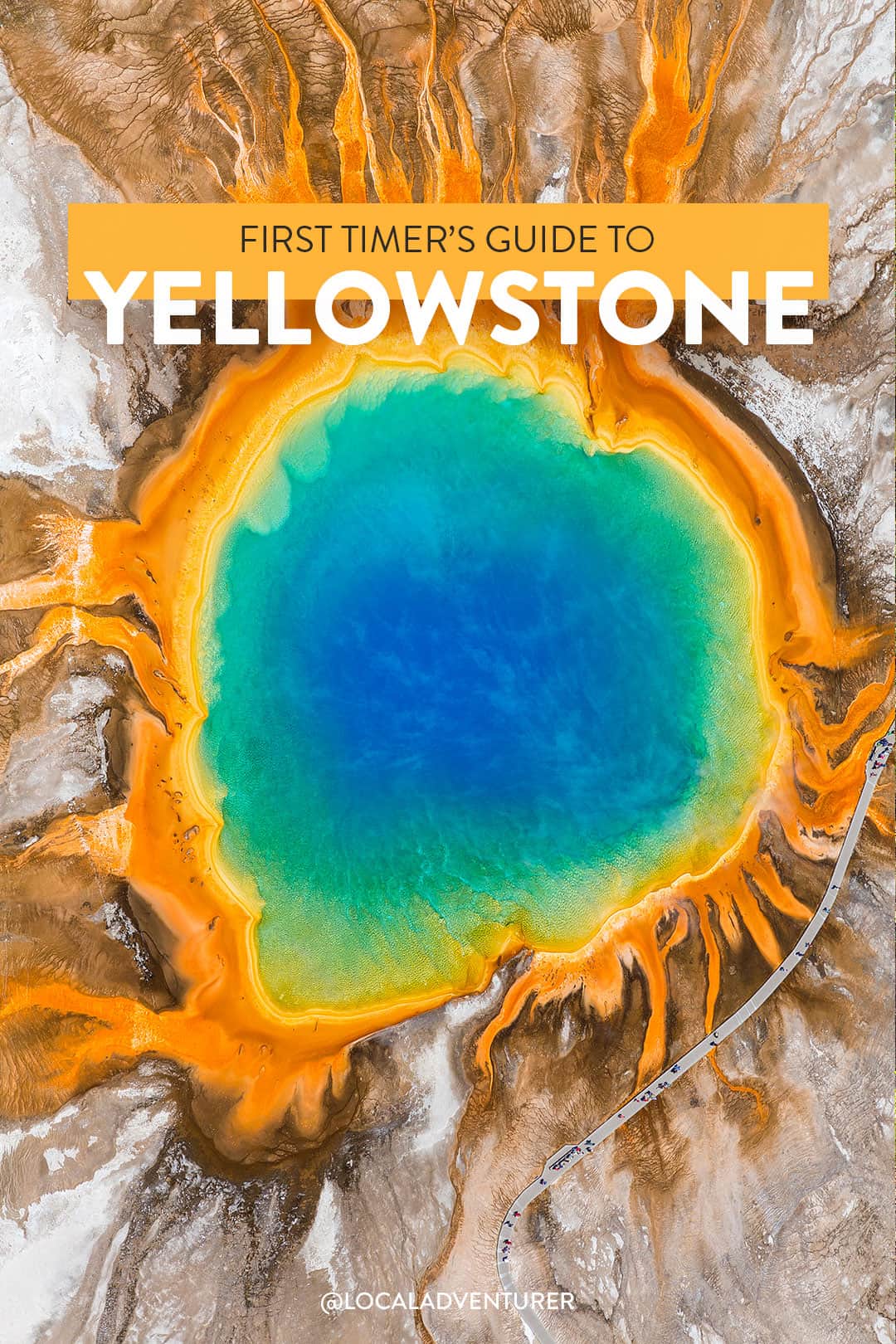
This post may contain affiliate links, where we receive a small commission on sales of the products that are linked at no additional cost to you. All opinions are always our own. Read our full disclosure for more info. Thank you for supporting the brands that make Local Adventurer possible.
Last Updated: May 30, 2025
Your Guide to Yellowstone – Best Things to Do in Yellowstone National Park
Before we get into it, we want to remind everyone to explore the parks responsibly using the 7 Leave No Trace Principles. Have a plan, stay on established trails, carry out anything you carry in, leave what you find, minimize campfire impact, respect wildlife, and be considerate of others.
TLDR
📍 Location – Yellowstone National Park is located primarily in northwestern Wyoming, with parts extending into Montana and Idaho. Visit to see its extraordinary geothermal features like Old Faithful, vibrant hot springs, and stunning landscapes filled with wildlife such as bison, elk, and bears. As the world’s first national park, it offers a rare chance to experience nature’s raw power and beauty all in one place.
🥾 Our Fave Spots -Mammoth Hot Springs Terraces, Artist’s Point, Hayden Valley, Grand Prismatic, Lamar Valley
🦬 Wildlife – Grizzly Bears, Black Bears, Bison, Elk, Wolves, Mule Deer, Pronghorn, Moose, and More
🛏️ Where to Stay – Search for Hotel Deals Near Yellowstone National Park
Overview of the Park
First of all, the park is huge and can be overwhelming with all there is to do. It’s the 8th largest national park in the US and spans 3,472 square miles with a low elevation of 5,282 feet and high elevation of 11,358 feet. There are over 900 miles of trails and 80% of the park is covered in forest.
Most of the park is located in the northeast corner of Wyoming and spills over to Idaho and Montana. There are 5 entrances to the park and once you’re in the roads form a large figure 8. To help you navigate through the park, we will highlight each major area of the park, and what we thought was worthwhile.
If you want a more detailed map, here’s one from NPS.
We’ll be writing more detailed guides on each area of the park.
See More: 11 Incredible Things to Do in Grand Teton National Park

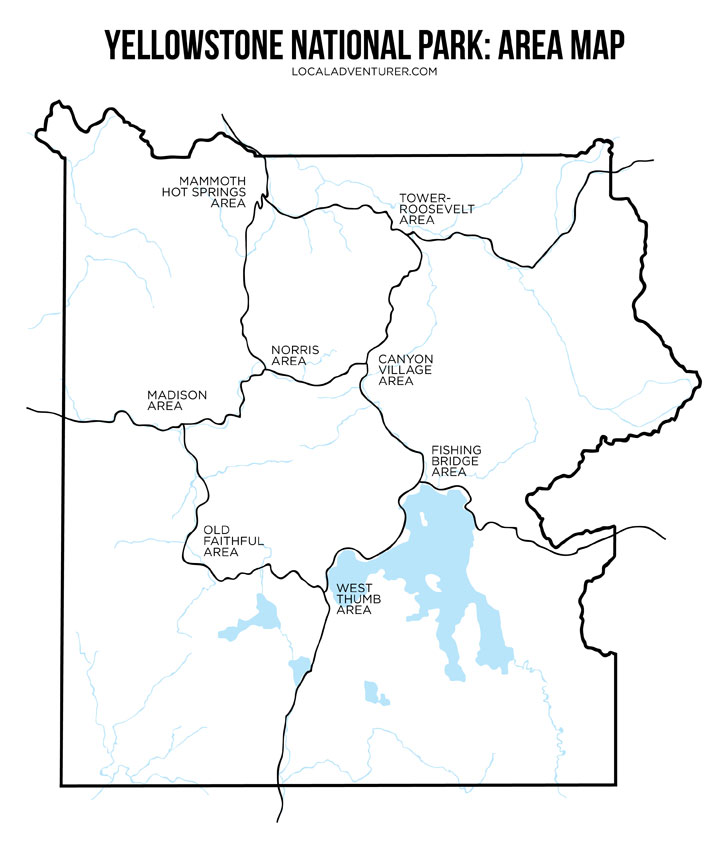
Visitor Centers
We always start our visit to the park at one of the Visitor Centers. You can learn more about the current conditions of the park as well as get insight from rangers on how to spend your time there. They are typically open late May to early October unless otherwise noted below. Hours vary based on location and season (see them here).
- Albright (Mammoth) Visitor Center (open year-round)
- Canyon Visitor Education Center (open late April to early November)
- Fishing Bridge Visitor Center & Trailside Museum
- Grant Visitor Center
- Madison Information Station and Trailside Museum
- Museum of the National Park Ranger (open late May to late September)
- Norris Geyser Basin Museum and Information Station
- Old Faithful Visitor Education Center
- West Thumb Information Station
- West Yellowstone Visitor Information Center (open year-round)
Mammoth Hot Springs Area
Though you can start by exploring the area from where you enter, for this guide, we’ll be starting from the northeast corner of the park and going clockwise. Mammoth Hot Springs is one of the most popular areas of the park where you see the iconic terraces.
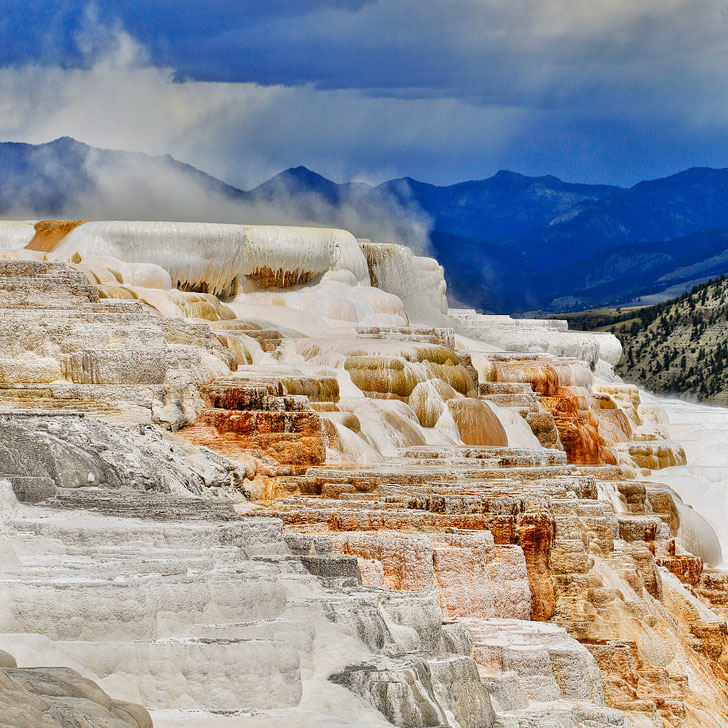
Highlights
- Albright Visitor Center – originally quarters for single Army officers but now you can learn about the history and wildlife of Yellowstone here.
- Mammoth Hot Springs Terraces – walk along the boardwalks and stairs that take you through the hydrothermal terraces that are constantly changing. The springs are colorful when active and white when dry. What you see: Opal Terrace, Liberty Cap, Hymen Terrace, Devil’s Thumb, Minerva Terrace, Palette Spring, Cleopatra Terrace, New Blue Spring, Main Terrace, Canary Spring, Cupid Spring, Grassy Spring, Dryad Spring, Mound Terrace, Jupiter Terrace, and Reservoir Springs.
- Upper Terrace Drive – 1.5-mile drive on a paved road. It wasn’t as scenic as we were told, but it’s not a crowded area and you see Prospect Terrace, New Highland Terrace, Orange Spring Mound, Bath Lake, White Elephant Back Terrace, and Angel Terrace. Horse Corral parking area has a view of Fort Yellowstone and Canary Springs.
- Historic Fort Yellowstone – take a tour of this wilderness outpost that was used in the 1800s to manage poaching, vandalism, and squatters
- Heritage and Research Center – a few miles away from Mammoth Hot Springs is this state-of-the-art facility that houses Yellowstone’s museum collection, archives, library, and archeology lab
- Old Gardiner Road – see the scenery and Yellowstone River along this dirt road for driving, cyclists, hikers, and cross-country skiers. You can see elk, bison, and antelope here.
- Roosevelt Arch – beautiful stone arch at the North Entrance dedicated to the president who was famous for his conservation efforts.
- Boiling River – you can take a dip in the secret but not-so-secret Boiling River where the boiling water of the hot springs meets the cool water of the river making it just the right temperature to enjoy. It can get really crowded.
- Undine Falls – upper and lower falls of lava creek. It’s a quick stop.
Popular Day Hikes
- Beaver Ponds Loop (5 miles RT, 3-4 hours, moderately strenuous)
- Bunsen Peak (4.6 miles RT, 2-3 hours, △1,300 feet, moderately strenuous) – tallest mountain in the Gallatin Range
- Lava Creek (8.5 miles RT, 2-3 hours, moderately strenuous)
- Rescue Creek (16 miles RT, 8-12 hours, strenuous)
- Sepulcher Mountain (11 miles RT, 6-8 hours, △3,400 feet, strenuous)
- Wraith Falls (1 mile RT, 0.5-1 hour, easy) – 90-foot cascades
Tower-Roosevelt Area
The Tower-Roosevelt Area is special because Thomas Moran’s paintings of Tower Falls and Calcite Springs Overlook played an important role in the establishment of Yellowstone National Park in 1872.
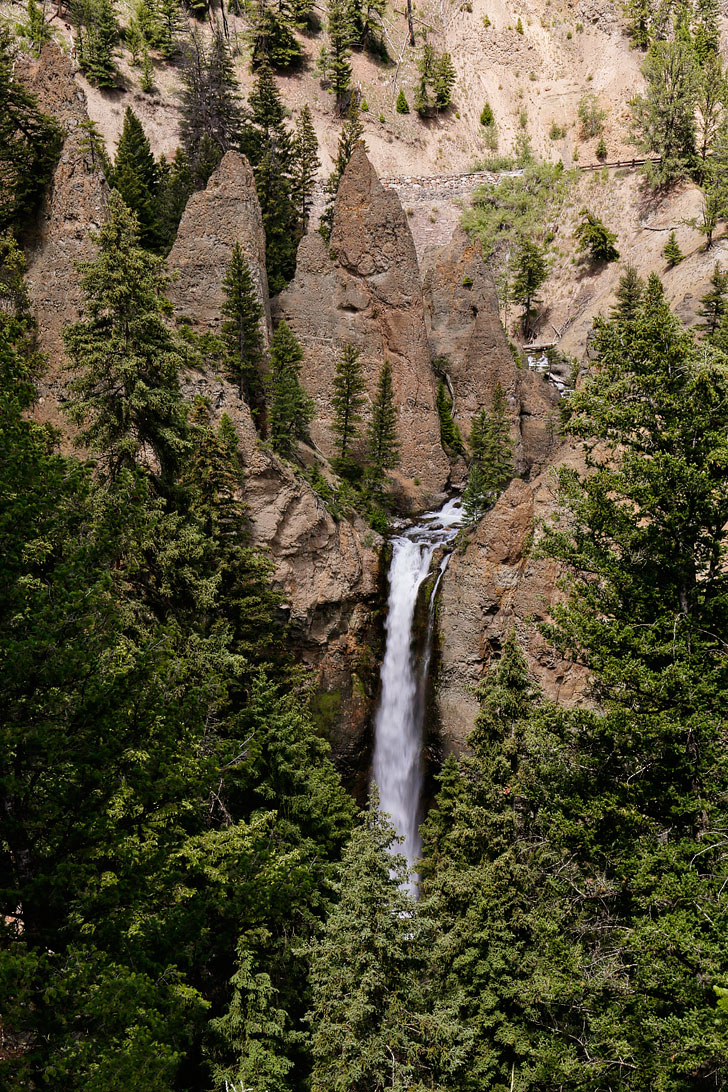
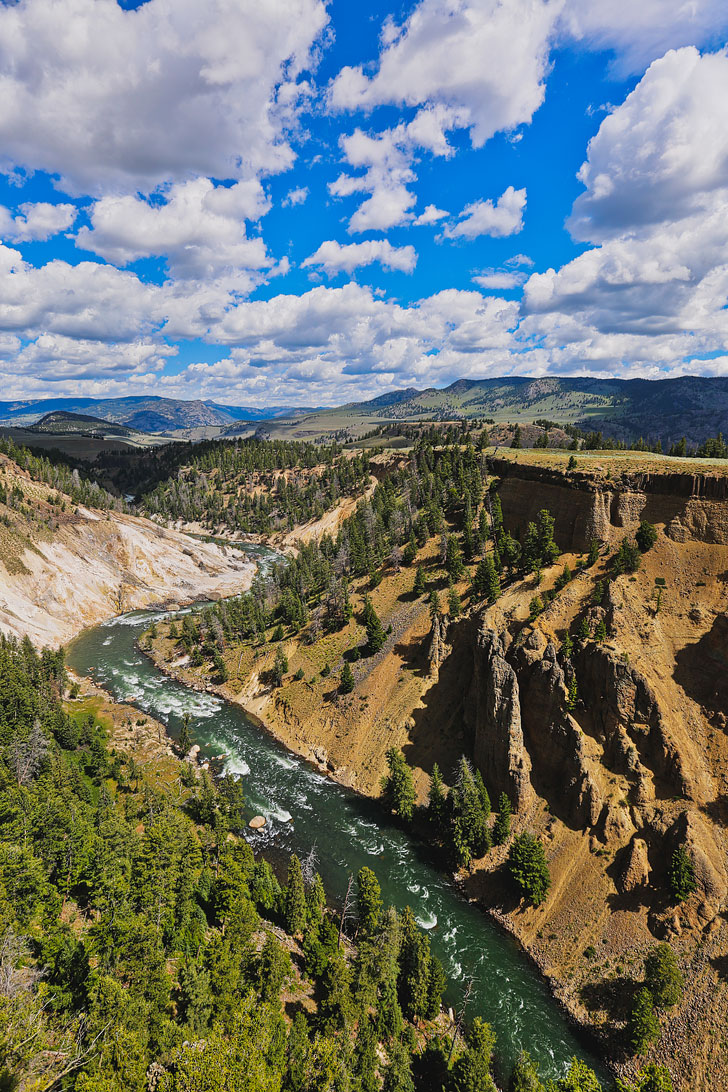
Highlights
- Blacktail Plateau Drive – 6-mile scenic one-way drive through elk creek gorge that is partly paved and partly gravel. Avoid driving it if it rained recently. It’s a popular area to spot black bears. We drove it three times on different days and unfortunately didn’t see any here.
- Petrified Tree – Specimen Ridge has the largest concentration of petrified trees in the world.
- Roosevelt Lodge – built in 1920
- Calcite Springs Overlook – short walk to see the Grand Canyon of Yellowstone at the narrowest point, a 132 waterfall, and basalt columns
- Tower Fall – 132-foot waterfall that’s been documented since the 1800s.
- Lamar Buffalo Ranch – historic ranch originally built to increase bison herd sizes
- Lamar Valley – one of the most popular spots for wildlife viewing. We only saw pronghorn and faraway wolves through binoculars, but you can also find bison, black bears, bighorn sheep, elk, grizzlies, and mule deer too.
Popular Day Hikes
- Garnet Hill Loop (7.6 miles RT, 4-5 hours, moderate)
- Hellroaring (6.2 miles RT, 3-4 hours, strenuous)
- Lost Lake Loop (2.8 miles RT, 1-2 hours, △300 feet, moderate)
- Slough Creek (to First Meadow: 3.4 miles RT, 2-5 hours, moderate)
- Trout Lake (1.2 miles RT, 0.5-1.5 hours, moderate) – see river otters, cutthroat trout, and waterfowl
- Yellowstone River Picnic Area (3.7 miles RT, 2-3 hours, moderate)
Canyon Village Area
This area is known as the Grand Canyon of Yellowstone. It’s roughly 20 miles long and has one of the most popular day hikes, plus gorgeous views of waterfalls and wildlife.
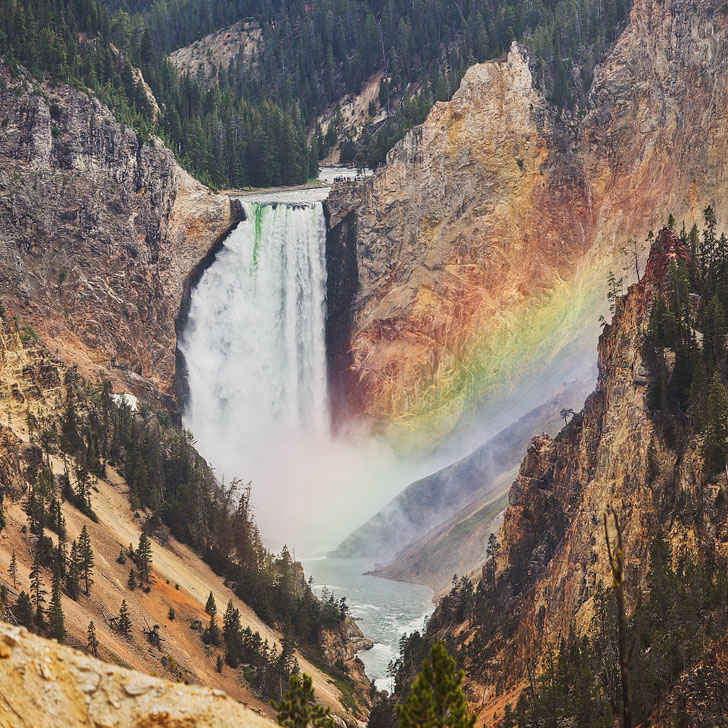
Highlights
- Canyon Visitor Education Center – learn about the supervolcano, geyser, and hot springs at Yellowstone
- North Rim Drive – lots of pullouts to see the canyon. Viewpoints include Lookout Point, Grand View, and Inspiration Point to see Lower Falls of Yellowstone.
- Lower Falls – the larger of the two falls, check out this 308 ft beauty from Lookout Point, Red Rock Point, Artist Point, Brink and Lower Falls Trail, South Rim Trail, and Uncle Tom’s Trail.
- South Rim Drive – leads to Uncle Tom’s Trail and Artist Point.
- Artist’s Point – one of the most popular spots in the park giving you a great view of the canyon.
- Upper Falls – at 109 ft, check out the falls from Upper Falls Trail.
- Mount Washburn Hike – hike to the 10,243 feet peak to get panoramic views and look for bears along the hillsides
- Chittenden Road – short drive up to a great view near Mount Washburn
- Hayden Valley – see grizzly bears, bald eagles, bison, black bears, elk, and wolves
Popular Day Hikes
- Cascade Lake (5 mile RT, 2.5-3.5 hours, easy) – grizzly habitat
- Grebe Lake (6.2 mile RT, 3-4 hours, moderately easy)
- Observation Peak (9.6 miles, 5 hours, △1,400 feet, strenuous)
- Ribbon Lake Loop (5.8 miles RT, 3-4 hours, moderately easy)
- Seven Mile Hole (10 miles, 5-8 hours, strenuous) – starts at Glacier Boulder.
- Mount Washburn (from Dunraven Pass: 6 miles RT, 3-6 hours, △1,343 feet, strenuous || from Chittenden Road: 5 miles RT, 2.5-4 hours, △1,393 feet, strenuous)
- Uncle Tom’s Trail (0.7 mile RT, 1-2 hours, △275, moderate) – great spot to see Lower Falls.
Fishing Bridge Area
The Fishing Bridge area includes Lake Village and Bridge Bay. As the name implies, it was historically a popular spot to fish, but now that fishing is no longer allowed, it’s become a place to watch fish instead. Check out the bubbling sounds and smells of the mud pots and fumaroles. This was one of the least exciting part of the park for us, but it was also a good place to get away from the crowds.
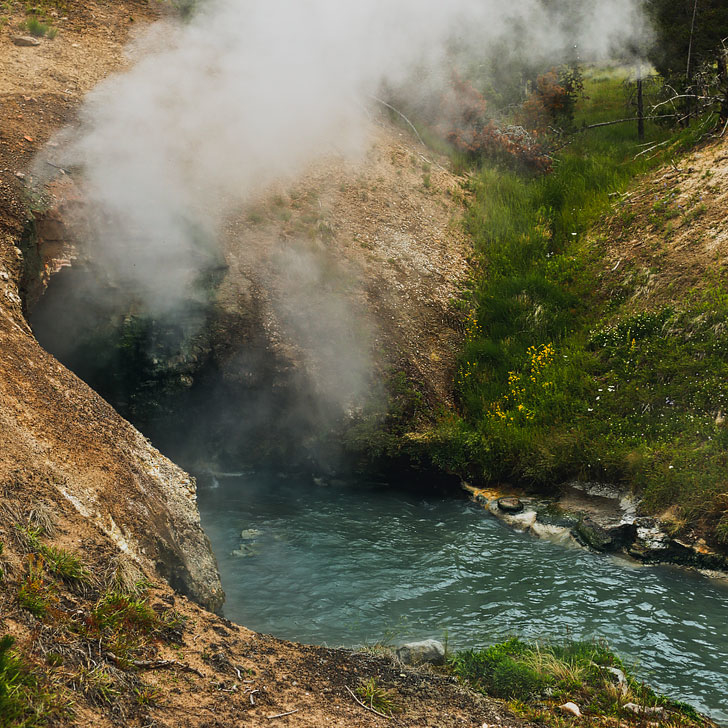
Highlights
- Fishing Bridge – watch fish and check out the bridge that was built in 1937
- Yellowstone Lake – 136-square mile basin part of the large caldera left by a large volcanic eruption
- Mud Volcano & Sulphur Caldron – check out mudpots and fumaroles (steam vents). We also saw a cute group of short-tailed weasels here.
- Pelican Valley – another great spot for wildlife viewing in hopes to spot grizzly bears, bison, elk, and more
- Natural Bridge – short hike to a beautiful natural bridge
Popular Day Hikes
- Avalanche Peak (4.2 miles RT, 3-4 hours, △2,100 feet, extremely strenuous)
- Elephant Back Mountain (3.5 miles RT, 1.5-2.5 hours, △800 feet, moderately strenuous) – panorama of Yellowstone Lake
- Natural Bridge (2.5 miles RT, 1-2 hours, easy)
- Pelican Creek (.6 mile RT, 0.5-1 hour, easy)
- Pelican Valley (6.2 miles RT, 3-4 hours, moderately easy)
- Storm Point (2.3 miles RT, 1-2 miles, easy)
West Thumb Area
The West Thumb area is home to the largest geyser basin on the shore of Yellowstone Lake. There are tons of hydrothermal features and even some underwater geysers. You can explore via the boardwalks or do a guided kayaking trip. This was my personal favorite area of the park. It was moderately trafficked in comparison to other areas of the park and had beautiful blue hot springs.
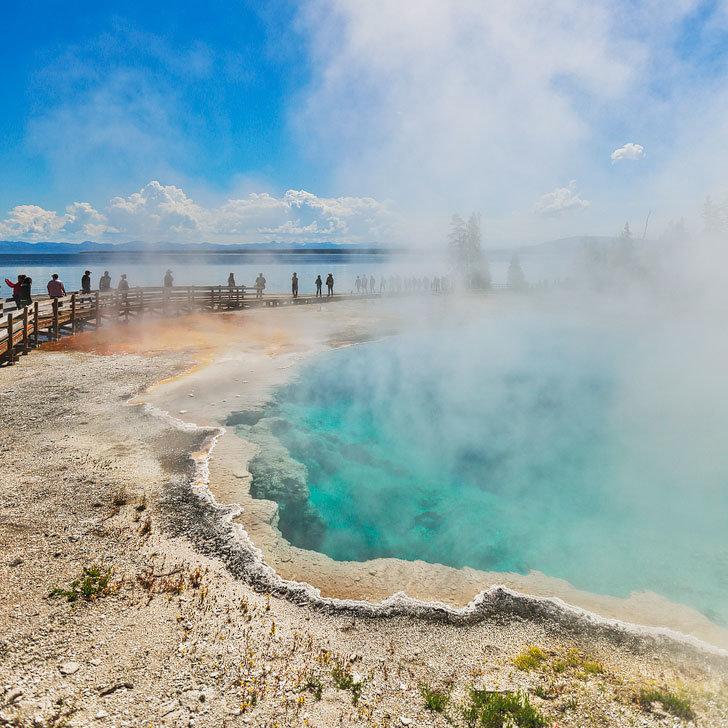
Highlights
- West Thumb Geyser Basin – hydrothermal features along Yellowstone Lake. What you see: Fumaroles, Twin Geysers, Hillside Geyser, Abyss Pool, Black Pool, Big Cone Fishing Cone, Lakeshore Geyser, Lakeside Spring, Seismograph and Bluebell Pools, Thumb Paint Pots, Surging Spring, Collapsing Pool, Ledge Spring, Percolating Spring, Thumb Geyser, Perforated Pool, Ephedra Spring, and Blue Funnel Spring.
- Grant Village Visitor Center – learn about the role fire that has shaped the park
- Shoshone Lake – second largest lake in Yellowstone
- Snake River – originates in Yellowstone and continues through Grand Teton National Park
Popular Day Hikes
- Duck Lake (0.8 mile RT, .5-1 hour, easy)
- Lake Overlook (1.5 miles RT, 1 hour, △400, moderately strenuous)
- Riddle Lake (4.8 miles, 2-3 hours, easy)
- Shoshone Lake (5.8 miles RT, 2-3 hours, easy)
- Yellowstone Lake Overlook (1.5 miles RT, 1-2 hours, moderately strenuous)
- West Thumb Geyser Basin (0.6 mile RT, 0.5-1 hour, easy)
Old Faithful Area
This area is easily the most crowded area of the park with the two most popular attractions: Old Faithful and the Grand Prismatic Spring. There are 3 main geyser basins: Upper, Midway, and Lower.
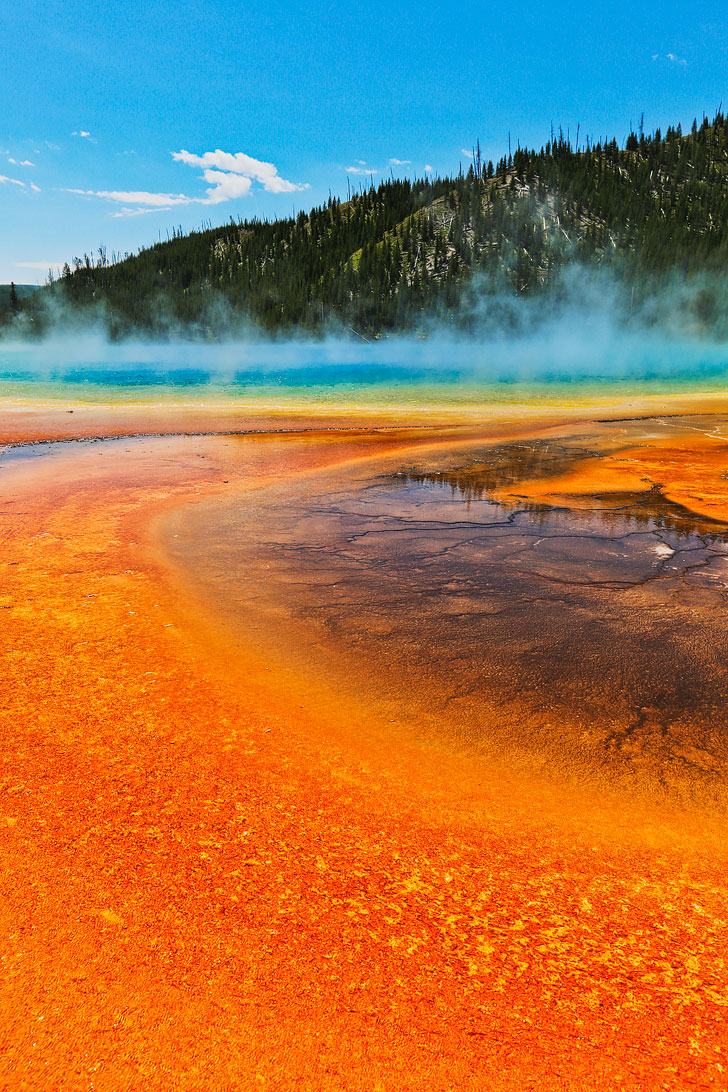
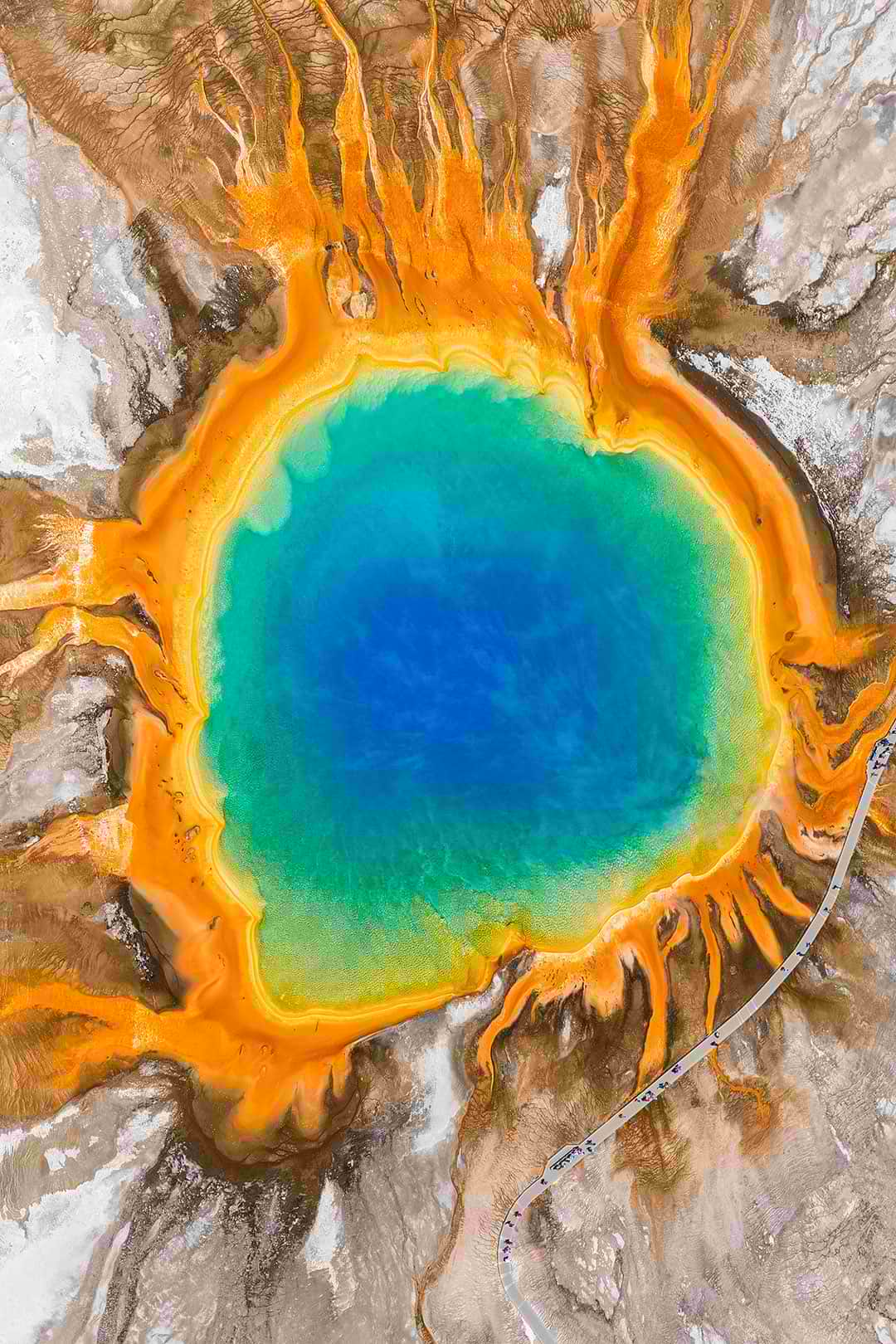
Highlights
- Upper Geyser Basin has the largest number of fragile features in the park (150 hydrothermal features in one square mile) including Old Faithful, Beehive Geyser, Castle, Grand, Daisy, and Riverside, Morning Glory Pool, and more.
- Old Faithful Visitor Center, Upper Geyser Basin – learn more about the geology of this amazing geyser and find out when to expect it to erupt (usually between 60-110 minutes between each eruption. See prediction times here).
- Old Faithful Inn, Upper Geyser Basin – built in 1903-4, it is one of the last remaining log hotels in the US.
- Midway Geyser Basin – Yellowstone’s largest hot spring, Grand Prismatic Spring
- Lower Geyser Basin – Fountain Paint Pots and Great Fountain (which only erupts twice a day within a 2-hour window)
- Lonestar Star Geyser – this geyser erupts every three hours and since it’s a bit off the main boardwalks, it will typically be less crowded
Popular Day Hikes
- Fairy Falls (5 miles RT, 2-4 hours, easy) – tall skinny waterfall with a great view of Grand Prismatic Spring
- Grand Prismatic Spring Overlook (1.2 miles RT, 0.5-1.5 hours, easy)
- Lone Star Geyser (4.8 miles RT, 2-3 hours, easy)
- Mallard Lake (6.8 miles RT, 4-6 hours, moderate-difficult)
- Mystic Falls (2.4 miles RT, 1.5-2.5 hours, moderate-difficult)
- Observation Point (1.6 miles RT, 1-2 hours, △160 feet, difficult)
Madison Area
Artist Paintpots and Firehole Falls both fall in the Madison Area. There are lots of short easy hikes to check out and even a swimming area that’s popular on hot, summer days.
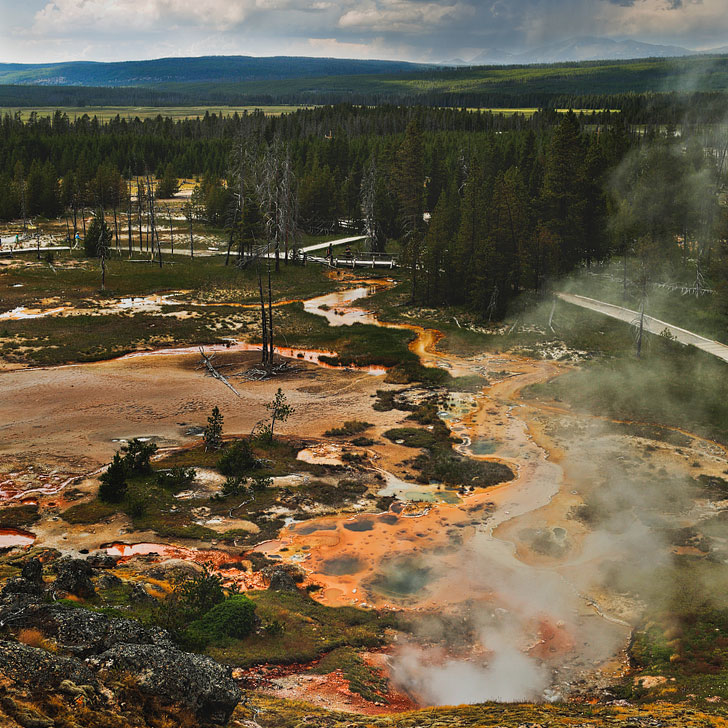
Highlights
- Artist Paintpots – this small thermal area has colorful hot springs, mudpots, and a section of burned forest
- Gibbon Falls – 84-foot cascading waterfall
- Madison Information Station – a National Historic Landmark that has been around since 1929-30 is now a Yellowstone Forever bookstore
- Monument Geyser Basin – dormant thermos-bottle shaped geyser cones
- Terrace Springs – small thermal area with a short boardwalk
- Fishing – fish the Madison or Firehole River
- Firehole Canyon Drive – beautiful scenic drive past 800-foot thick lava flows
- Firehole Falls – 40foot waterfall with a popular swimming area when it’s warm
Popular Day Hikes
- Artists Paintpots (1 mile RT, 0.5-1 hour, easy)
- Harlequin Lake (1 mile RT, 0.5-1 hour, easy)
- Monument Geyser Basin (2 mile RT, 1-2 hour-moderate) – small geyser area
- Purple Mountain (6 miles RT, 4-6 hours, strenuous)
Norris Area
This is the hottest and oldest thermal area in Yellowstone. There are two main areas to explore: Porcelain Basin and Back Basin. There are some extremely active geysers.
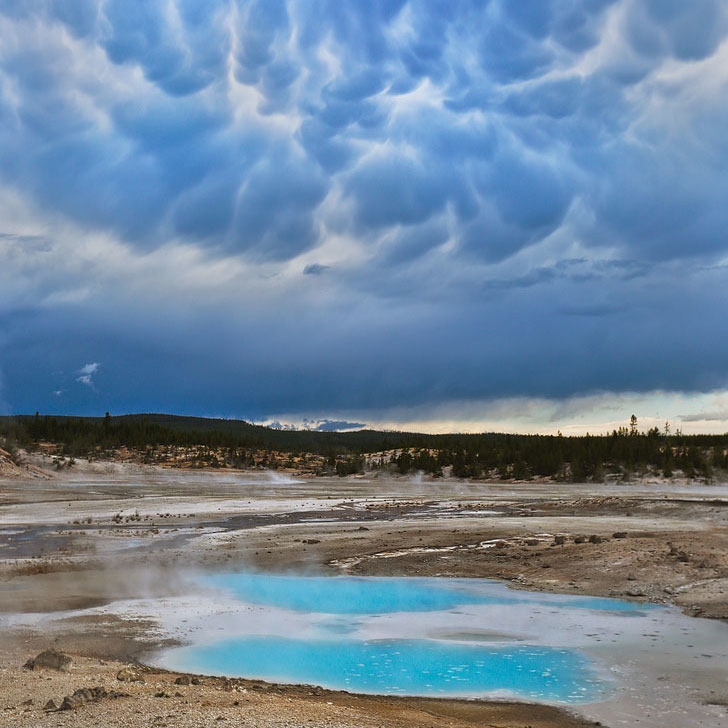
Highlights
- Norris Geyser Basin Museum – one of the original trailside museums built in 1929-30
- Porcelain Basin – barren of trees, walk along the boardwalk to check out all the thermal features: Congress Pool, Porcelain Springs, Hurricane Vent, Sunday Geyser, Constant Geyser, Whirligig Geyser, Pinwheel Geyser, Whale’s Mouth, Crackling Lake, Black Growler Steam Vent, Ledge Geyser.
- Back Basin – a wooded area with geysers and hot springs spread throughout. Here’s what you will see: Emerald Spring, Steamboat Geyser, Cistern Spring, Black Pit Spring, Echinus Geyser, Arch Steam Vent, Mystic Spring, Puff ‘n Stuff Geyser, Black Hermit Caldron, Green Dragon Spring, Blue Mud Steam Vent, Yellow Funnel Spring, Porkchop Geyser, Pearl Geyser, Vixen Geyser, Corporal Geyser, Veteran Geyser, Palpitator Spring, Fearless Geyser, and Minute Geyser.
- Roaring Mountain – large thermal area that makes a hissing sound
- Gibbon River – beautiful river popular with fly-fishers
- Virginia Cascades – three-miles of old roads take you past 60-foot high Virginia Cascades (you can cross-country ski in the winter)
- Museum of the National Park Ranger – talk to a retired ranger and learn more about the history of the rangers who protect our parks.
Popular Day Hikes
- Ice Lake Trail (0.6 miles RT, 0.5 hr, easy)
- Grizzly Lake Trail (3.5 miles RT, 1.5-2.5 hrs, △320 feet, moderate)
- Monument Geyser Basin (2 miles RT, 0.5-1.5 hrs, easy)
- Norris Geyser Basin Trail (to Porcelain Basin: 1.6 mile loop, 0.5-1.5 hours, easy || to Back Basin: 2 mile loop, 1-2 hours, easy)
Winter Tours
Most park roads close by early November, but that doesn’t mean you can’t still see the park. Once there’s enough snow in the park, roads open to “oversnow” travel only. This usually happens by mid-December, when you can hop on a guided snowmobile or snow coach tour. This is a unique time to see the park since the crowds are much smaller. By mid-March, plowing begins with plans to re-open to normal cars in mid-April.
Note: Only authorized companies can provide tours. You can also apply for the Non-Commercially Guided Snowmobile Access Program here.
Wildlife Viewing
One of the main reasons people visit Yellowstone National Park is to see the wildlife! Some people refer to Yellowstone as the Serengeti of North America. You can find bears, bison, elk, moose, and more.
When to Go
Animals tend to feed early morning and evenings so they are more likely to be up and moving around. Bears come out of hibernation in March and April, then head up to higher elevations when it’s hot in the summer. Mid-September is the elk rut season. If you’re hoping to see wolves, coyotes, and foxes winter is a great time because they are easier to see against the snow. Their pups typically come out in may.
Where to Go
Although it depends on the season and weather, these are generally the most popular areas to view wildlife.
- Fishing Bridge: Grizzly Bears
- Hayden Valley: Bison, Black Bears, Elk, Grizzly Bears, Wolves
- Lamar Valley: Bison, Black Bears, Bighorn Sheep, Elk, Grizzly Bears, Mule Deer, Pronghorn, Wolves
- Mammoth Hot Springs: Bison, Black Bears, Elk, Mule Deer
- Madison: Bison, Elk
- North Entrance: Bighorn Sheep, Bison, Elk, Pronghorn
- Northeast Entrance: Moose
- Old Faithful: Bison, Elk
- South Entrance: Moose
- West Thumb: Elk, Moose
Safety and Tips
- This isn’t a zoo. Seeing wildlife takes planning, timing, and a bit of luck.
- Remain at least 100 yards away from bears or wolves, and at least 25 yards from all other wildlife.
- Never, never, never approach or pursue animals just to take its picture or see it closer up. It’s illegal to remain near or approach wildlife.
- If an animal comes towards you, back up slowly.
- Use pullouts when seeing animals.
- Read more about bear safety here.
Best Backcountry Hikes
The best way to avoid crowds, even during the summer, is to get away from the easily accessible areas. There are plenty of backcountry hikes that the vast majority of visitors never explore. We didn’t do any backcountry hikes because quite frankly we were terrified of bears.
The week before our visit, a US forestry officer got mauled by a grizzly near our campground while we were staying in Glacier (it’s very rare and hadn’t happened in over a decade). It was also a very bad idea to read up on every fatal bear attack in North America on our drive to Yellowstone.
Keep in mind, that you should plan appropriately for these hikes. Have the right gear, know how to get around and navigate trials, bring plenty of food and water, and know what to do if you encounter wildlife. If you plan on camping, you will need to get backcountry camping permits.
- Thorofare and South Boundary Trails (68.2 miles one-way, △5,738 ft) – One of the greatest backpacking routes in the US with some big river crossings and plenty of opportunities to see wildlife.
- Firehole Meadows (17.2 miles one way, △1,274 feet) – Connects some of Yellowstone’s best features. See geysers, hot springs, waterfalls, and meadows.
- Shoshone Lake (11-mile loop, △393 feet) – Explore some of the most remote shores at the lower 48s largest backcountry lake.
- Bechler River Trail (48.6 miles RT, △4,199 feet) – Head the southwestern area of Yellowstone to explore the wettest part of the park. See rapids, waterfalls, and trek through heavy woods.
- Specimen Ridge (17.6 miles one way, △3,633 feet) 0 A great trail for adventurous hikers that requires you to be good at route finding, river crossings, and light scrambling.
- Agate Creek Trail (14.4 miles RT, △1,336 feet) – See wildlife and thermal features on this hike. This one also requires some scrambling and route finding.
- Black Canyon of the Yellowstone (14 miles one-way, △1,740 feet) – Explore Yellowstone’s deep canyons.
- Sky Rim Trail (16.8 miles one-way, △3,000 feet) – A loop with beautiful panoramic ridges and views.
- Mary Mountain Trail (20.3 miles, △1,423 feet) – Explore the Central Plateau grasslands and woods.
When to Visit Yellowstone
Yellowstone can be seen all year round, but Summer is by far the busiest season. More than half of the annual visitors come between June and August.
- Summer (June-August) – This is the busiest season of the year. It’s the best time to see a variety of wildlife – wolves, bears, moose, elk, and deer. Activities and facilities are in full swing. Temperatures usually stay around 70F with cooler temperatures at night, and even getting below freezing in higher elevations. Thunderstorms are common in the afternoons.
- Fall (September-October) – Fall is mating season, and it’s a great time to see elk, bison, and bears.Bears are prepping for hibernation and are active this time of year. Crowds start to thin and campgrounds begin to close, but most facilities are still open and accessible. Daytime temperatures can be anywhere from 30F to 60F. Night time brings temperatures in the teens. The foliage gives you a beautiful backdrop, but you may also start getting snow.
- Winter (November-March) – The slowest time of year and the hardest time to get around. It’s limited to ‘oversnow’ travel and guided tours, so you won’t be dealing with the crowds. If you want to avoid the crowds, most people recommend visiting in the winter if you can brave the cold (0-20F and sub-zero temperatures at night). The bears will be hibernating, but this is when it’s easier to spot wolves, foxes, and coyotes against the snow.
- Spring (April-May) – Temperatures start to rise and roads begin to open. Hiking reopens at lower elevations while skiing and snowshoeing is still accessible at higher elevations. Spring weather is similar to Fall, but it’s when there are babies. When the greenery hasn’t grown in, it’s also easier to spot the animals. Daytime temperatures can be anywhere from 30F to 60F. Night time brings temperatures in the teens. You also may also start getting snow.
Check the most up-to-date weather here.
Directions + Roads
The park has limited road access, especially outside of the summer and fall months. Be prepared with the right type of car depending on what you want to see. Roads typically close in early November due to the weather, except for the road between Mammoth Hot Springs and the northeast entrance, which is open year-round. Find the most up-to-date info on the road conditions here.
Essential Tips
- Permits and Passes: Save time at the gate by picking up an America the Beautiful National Parks Pass before heading to the park. It gets you into all the National Parks, National Forests, BLM, and more.
- Driving around the park takes longer than you think and you need a lot of patience. If you visit during the summer, there are A LOT of people at the park. There are also plenty of people who don’t know how to use pullouts and will stop in the middle of the road causing traffic jams. Then add in construction, animal crossings, and the long distances driving around the park.
- Hold onto your hats. The wind can take you by surprise and carry it into areas you’re not allowed to go. You’ll see plenty of lost hats around the park.
- Bears are all over the park. We talk about Bear Safety here.
- DO NOT approach the animals. These are wild animals and they are unpredictable.
- Stay on boardwalks and paths. They are there to protect us and the land. Keep in mind that the park sits on top of an active volcano! We encountered several groups of people who disregarded all the signs and walked all over fragile areas to get photos. I regret not being bolder and telling them off, but maybe you can do what we couldn’t. If it’s not enough that it’s disrespectful, you can read this to know that it’s also for your own safety.
- Summer brings afternoon thunderstorms. Keep that in mind when planning your day. We got pretty far out on a trail and thought we might get hit by lightning.
- Hot springs are very dangerous! These are not the ones you want to take a dip in. They injure and kill more people than any other natural feature in the park.
- Avoid crowds by starting early. Peak hours are from 9 am to 3 pm, and the busiest months are June-August.
- Pick up a day hikes sampler from the visitor center.
- Find the most up-to-date operating hours here.
- Get a preview by checking out one 9 webcams.
- Check out current road conditions here.
- Use AllTrails+ to have trail maps offline.
Photography Tips
- Camera Equipment (Camera, 35mm + 70-200mm Lenses, Tripod)
- Bring an extra long lens for wildlife, this is the one we currently use when we travel.
- Have a good backpack that you can easily carry your gear around in. These are our favorite.
- Geyser spray will ruin your lenses. Make sure you protect or wipe down quickly. Bring a raincoat at Beehive and watch the wind movement. I got drenched. The geyser sprays as far as the benches on the left, which was a lot farther than anyone there anticipated.
- If you’re visiting during the winter, don’t forgot extra batteries since they die quicker.
Where to Eat
The nice thing about a park that has so many visitors is that they also have to have plenty of amenities, including restaurants and stores. During the busy season, it will still be extremely crowded during meal times so try to go at off hours. Also, as it is in most parks, the prices are on the higher side, so if you’re on a budget, plan on bringing food with you.
Restaurants
- Mammoth Hot Springs Dining Room, Mammoth Hot Springs Area
- Terrace Grill, Mammoth Hot Springs Area
- Old Faithful Inn Dining Room, Old Faithful Area
- Old Faithful Snow Lodge Dining Room, Old Faithful Area
- Old Faithful Lodge Cafeteria, Old Faithful Area
- Geyser Grill, Old Faithful Area
- Bear Paw Deli, Old Faithful Area
- Grant Village Dining Room, West Thumb Area
- Lake House Restaurant, Fishing Bridge Area
- Lake Yellowstone Hotel Dining Room, Fishing Bridge Area
- Lake Yellowstone Hotel Deli, Fishing Bridge Area
- Lake Lodge Cafeteria, Fishing Bridge Area
- Canyon Lodge Dining Room, Canyon Village Area
- Canyon Deli, Canyon Village Area
- Canyon Lodge Cafeteria, Canyon Village Area
- Roosevelt Dining Room, Tower-Roosevelt Area
Stores
- Mammoth General Store, Mammoth Hot Springs Area
- Upper General Store, Old Faithful Area
- Lower General Store, Old Faithful Area
- Fishing Bridge General Store, Fishing Bridge Area
- Lake Village General Store, Fishing Bridge Area
- Bridge Bay Mini Store, Fishing Bridge Area
- Grant Village General Store, West Thumb Area
- Grant Village Mini Store, West Thumb Area
- Canyon General Store, Canyon Village Area
- Roosevelt General Store, Tower-Roosevelt Area
- Tower Fall General Store, Tower-Roosevelt Area
Best Places to Stay
Yellowstone is a massive park, so if you can stay in the park, it will save you time that you would otherwise be spending just getting in and out. There are plenty of options, but also a lot of people visiting, so be sure to book your accommodations as early as possible. Some of the lodges and reservable campgrounds are filled up a year in advance during the busiest times of the year.
Lodges
There are 9 lodges in the park with over 2,000 rooms. If you’re visiting from late spring through fall, all of them will be open. If you’re visiting in the winter, only Old Faithful Snow Lodge and Mammoth Hot Springs Hotel are open. You can see if they are currently open/close here, and also their availability.
- Canyon Lodge (Just North of the Center of the Park)
- Grant Village Lodge (Center of the Park)
- Lake Hotel (Center of the Park)
- Lake Lodge (Center of the Park)
- Mammoth Hotel and Cabins (North Entrance)
- Old Faithful Inn (Near Main Visitor Center)
- Old Faithful Lodge (Near Main Visitor Center)
- Old Faithful Snow Lodge (Near Main Visitor Center)
- Roosevelt Lodge (North Side of the Park)
Camping at the Park
If you’re looking to camp, there are a bunch of different campgrounds. There are two separate reservation systems. Most are open from late Spring to Fall, except for Mammoth Campground, which is open year-round. Check here for more info.
Reservable through Yellowstone National Park Lodges (these sites also charge tax and/or utility pass-through fees)
- Bridge Bay: $33 per night; 431 sites (5/16/25 – 9/1/25)
- Canyon: $39 per night; 272 sites (5/20/25 – 9/21/25)
- Fishing Bridge RV Park: $89/99 per night; 310 sites (5/9/25 – 10/12/25)
- Grant Village: $39 per night; 429 sites (6/6/25 – 9/14/25)
- Madison: $33 per night; 276 sites (5/2/25.- 10/19/25)
Reservable through Recreation.gov
- Indian Creek: $20 per night; 70 sites (6/13/25 – TBD)
- Lewis Lake: $20 per night; 84 sites (6/15/25 – 10/13/25)
- Mammoth: $25 per night; 82 sites (Open Year-Round)
- Pebble Creek: $20 per night; 27 sites (Closed in 2025)
- Slough Creek: $20 per night; 16 sites (6/15/25 – 10/13/25)
- Tower Fall: $20 per night; 31 sites (5/23/25 – 9/27/25)
Note: There are also backcountry campsites available.
Rving and Other Options
Most of the sites offer some sort of access for RVs. It’s best to check the site for details to see if your RV will fit. If you’re looking for full hook-ups, Fishing Bridge RV Park is the only site that offers that. Reservations book up extremely quick though.
If you can’t find a place to stay in the park, check the map below for other places to stay.
What to Pack
This will vary depending on whether you’re camping or in a hotel, what activities you’ll be doing, and what time of year you’ll be visiting. Here is a general list that will get you started.
- Food – we preferred packing our own food.
- Layers – temperatures change based on elevation
- Binoculars for Wildlife Viewing (serious viewers had spotting scopes)
- Rain Jackets
- Waterproof Hiking Shoes
- Camping Equipment (if camping)
- Camera Equipment (Camera, 35mm + 70-200mm Lenses, Tripod)
- Hiking Gear (Trekking Poles, Daypack)
- Water (Our Favorite Water Bottles)
What’s Nearby
Keep in mind some roads are closed during winter, which means you may have to take a longer way around.
- Grand Teton National Park (130 mi / 2 hr 35 min)
- Bighorn Canyon National Recreation Area (245 mi / 4 h 40 min)
- Little Bighorn Battlefield National Monument (241 mi / 3 h 58 min)
- Craters of the Moon National Monument (235 mi / 4 h 41 min)
- Hagerman Fossil Beds National Monument (297 mi / 5 h )
- Mount Rushmore National Memorial (519 mi / 8 h 50 min)
- Glacier National Park (376 mi / 6 hr 24 min)
- Devil’s Tower National Monument (472 mi / 7 h 25 min)
Planning Checklist
- Get comprehensive insurance for your trip.
- Download these helpful language apps.
- Find a great deal on Yellowstone hotels.
- Arrange a rental car for your trip.
- Book a tour for your visit.
- Get airport lounge access.
- Buy a travel charger to keep your devices charged.
- Get a new backpack for your trip.
- Buy a Yellowstone travel guide.
- Pack the appropriate shoes for your trip.
- Don’t forget your in-flight essentials.
- Download AllTrails+ to have trail maps offline.
What are you favorite things to do in Yellowstone?
Did you enjoy this post? Pin it for later
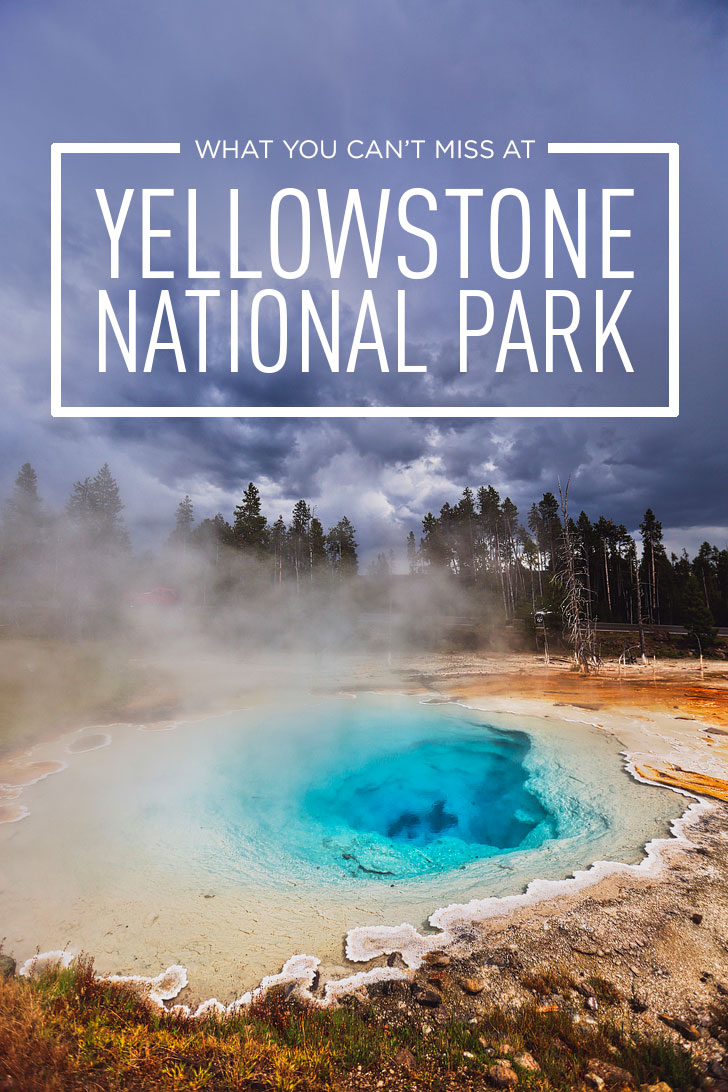
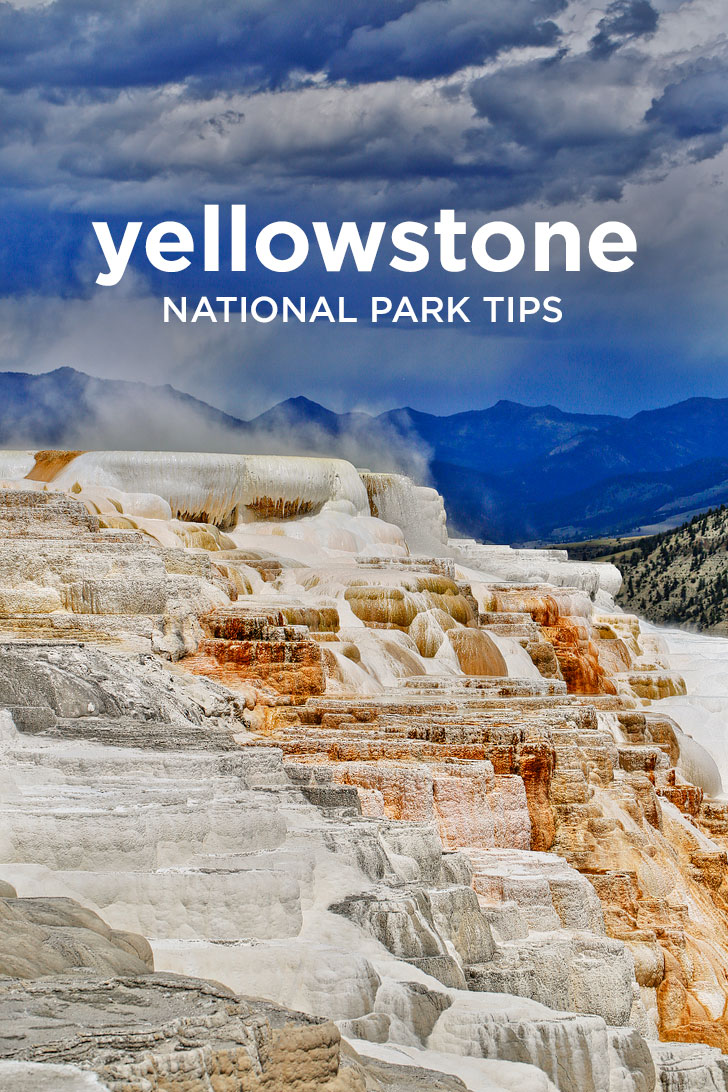

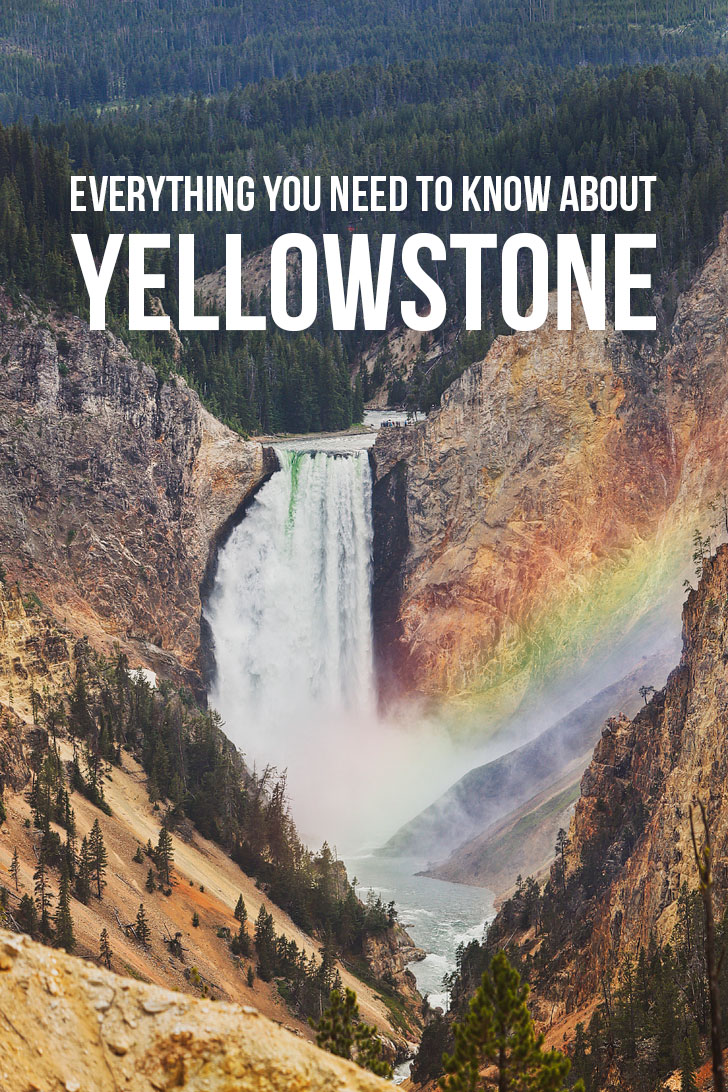

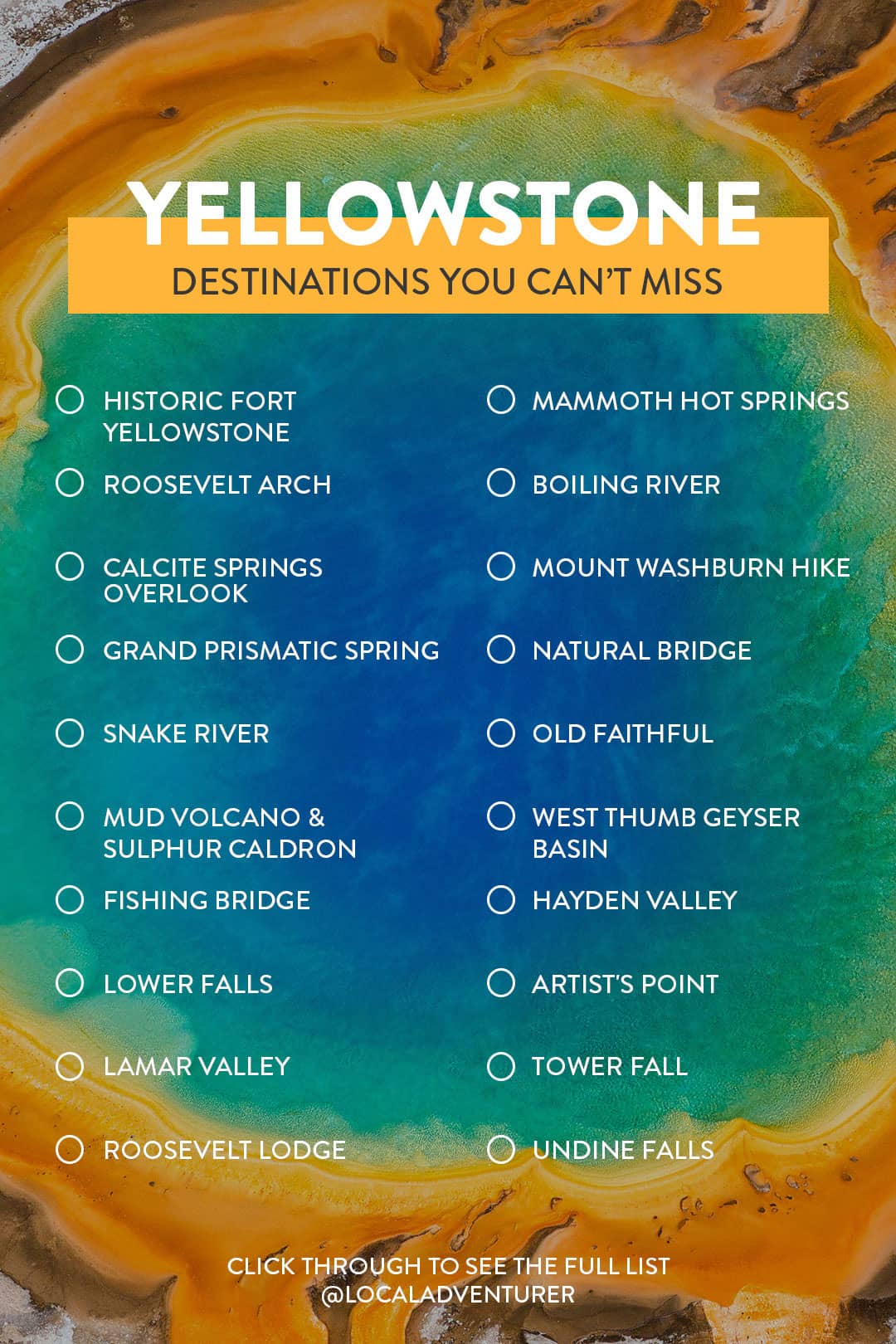
SEE MORE NATIONAL PARK GUIDES
⟡⟡⟡⟡⟡
“Discovery consists not of seeking new lands but in seeing with new eyes” – M. Proust

Esther + Jacob
Esther and Jacob are the founders of Local Adventurer, one of the top 5 travel blogs in the US. They believe that adventure can be found near and far and hope to inspire others to explore locally. They explore a new city in depth every year and currently base themselves in Las Vegas.
Follow on Instagram (E + J), YouTube, TikTok, and Pinterest.

